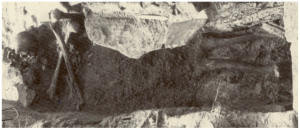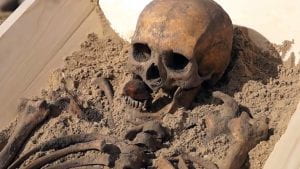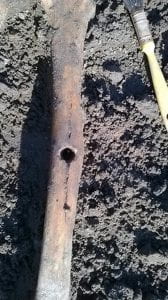With Halloween fast approaching we need to prepare for the many monsters that will come out to terrorize innocent victims. One such monster is the horrific undead blood-sucking vampire. Vampires have been around in folklore for ages. They are said to rise from the dead at night and kill living people. In order to prevent the vampires from rising villagers would cut off the corpse’s head, take out its heart, nail or weigh it down, reinforce the coffin so it can’t get out, or stab it repeatedly with wooden stakes. Some cultures thought that vampires had uncontrolled compulsions and would distract the vampire with tasks like picking up seeds in its coffin or untying fishing nets. Archaeologists have excavated many graves, especially from Europe that show signs of postmortem violence. Their limbs have holes from metal spikes and some even have rocks or bricks jammed in their mouths so they cannot bite people.
This vampire phenomenon has even spread to the US where a Connecticut cemetery was excavated. One of the burials had the remains rearranged so that the head and limbs were crossed on the chest similar to the pirate skull and crossbones.
So how we know how to rekill or restrain a vampire but how do we know who is a vampire? Folklore has many rules about how to identify a vampire. The main identifier is that when the body is exhumed, there is a lack of decomposition, however the body may also show signs of bloating, blackening, and other changes. They are often found with blood coming out of their mouths, eyes, nose, and even ears. The lore suggests this is because the vampire gorges on so much blood that it seeps out. The suspected vampire also produces a terrible smell, no rigor morits, and the hair and nails appear to still be growing. I don’t know about you but these all sound like common elements of natural decomposition. Especially considering that the lore specifies that most of these vampires appear in winter and take between 9 and 40 days to actually become vampires. All of these ‘vampire characteristics’ occur naturally during the early stages of putrefactions.
Now you know what to look out for if you come across a dead body. So, what are some signs in the living? Vampirism is essentially a plague. Once one person becomes a vampire, they infect those around them. Often, when a vampire dies their family and close friends die shortly after. And those most likely to become vampires die from murder, suicide, or the plague. The Connecticut vampire shows signs of having died from Tuberculosis which is a common plague and trend seen in vampire burials. The victims of TB would often cough blood from their mouths and take on a pale appearance. Sounds like a vampire, right? Because TB is extremely contagious and people lived in very close proximity to each other, it isn’t hard to see the connection between one death and the deaths of the rest of the family. The vampire was probably just the first victim of the plaque.
The vampire epidemics were probably responses to plagues with unknown origins and cures. People sought to explain the process of decomposition and illness in a world of superstition. These people were likely innocent victims of illness who were then violated after death. These burials provide more information about the living community than the dead community (or undead). How people treat their deceased tells archaeologists a lot about their culture. In this case vampire burials tell us about a time of superstition, fear, and sickness. So next time you open a coffin, don’t judge the skeleton by its burial. It might come back to haunt you.


